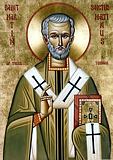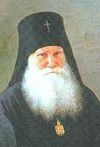

| Previous day | Next day |
| Old Style
October 12
|
Tuesday |
New Style
October 25
|
| 20th Week after Pentecost. Tone 2. | No fast.
|
![]() Martyrs Probus, Tarachus, and Andronicus, at Tarsus in Cilicia (304).
Martyrs Probus, Tarachus, and Andronicus, at Tarsus in Cilicia (304). ![]() St. Cosmas the Hymnographer, bishop of Maiuma (ca. 787).
St. Cosmas the Hymnographer, bishop of Maiuma (ca. 787).
Martyr Domnina of Anazarbus (286). St. Martin the Merciful, bishop of Tours (397). Sts. Amphilochius (1452), Macarius (1480), and Tarasius (1440), abbots, and Theodosius, monk (15th c.), of Glushitsa Monastery (Vologda), disciples of St. Dionysius of Glushitsa. Uncovering of the relics of St. Macarius of Zheltovodsk and Unzha (1671). Translation from Malta to Gatchina: of a Particle of the Life Giving Cross, the Filersk Icon of the Mother of God, and the relic of the Right Hand of John the Baptist (1799). St. Arsenius, archimandrite, of Svyatogorsk Monastery (1859). St. Euphrosyne (Mezenova) the Faster, schema-abbess, of Siberia (1918). Glorification of St. Philaret, archbishop of Chernigov (2009).
New Hieromartyr Lawrence (Levchenko), hieromonk, of Optina Monastery (1937). New Hiero-confessor Nicholas (Mogilevsky), metropolitan of Alma-Ata (1955).
“Jerusalem” (48) and “Kaluga” (1748) Icons of the Most Holy Theotokos.
Hieromartyr Maximilian, bishop of Noricum (284). St. Mobhi of Glasnevin (Ireland) (544). Martyr Edwin, king of Northumbria (633). St. Wilfrid, bishop of York (709). Translation of the relics of St. Sabbas the Sanctified from Rome to Jerusalem (1965). Virgin-martyr Anastasia of Rome (ca. 250). St. Theodotus, bishop of Ephesus. St. Jason, bishop of Damascus. St. Symeon the New Theologian [transferred from Great Lent, March 12] (1022). St. Theosebius the God-bearer, of Arsinoe on Cyprus.
Thoughts for Each Day of the Year
According to the Daily Church Readings from the Word of God
By St. Theophan the Recluse

Tuesday. [Col. 1:1-2, 7-11; Luke 8:1-3]
The Lord preaches, the women serve Him from their substance, and are thus as participants in his very preaching. It is not given to everyone to preach the Gospels, but everyone can help spread them, and be participants in this most important matter on the earth. There were many such participants, both men and women, at the time the holy apostles preached; and then at the time of their successors, and finally, throughout the entire history of the Church. Such participants exist to this day. Our apostles in the Caucasus and in various areas of Siberia labour zealously, suffering every need and deprivation. They continue the work of the Lord and the holy Apostles. Those men and women who send them help join the ranks of the women who served the Lord, and become worthy of equal recompense. The Lord said: He that receiveth whomsoever I send receiveth Me (John 13:20). This means that He equates Himself with the one who is sent to preach; it would follow that He equates the service rendered to his messengers with serving Him. According to the law of His goodness and truth, the way a person receives one determines the reward he will receive (Matt. 10:41). This would seem to be sufficient incentive to keep giving alms to help in the great work of preaching of the Gospels.
Articles
 Martyrs Probus, Tarachus, and Andronicus, at Tarsus in CiliciaThe Martyrs Tarachus, Probus, and Andronicus suffered for Christ in the year 304 at Tarsus in Cilicia. |
 Martyr Domnina of AnazarbusThe Martyr Domnina of Anazarbus lived in the region of Cilicia, and suffered for confessing Christianity. |
 Venerable Amphilochius the Abbot of GlushetsaSaint Amphilochius, Abbot of Glushetsa, already a monk of priestly rank, came from Ustiug to Saint Dionysius of Glushetsa (July 1) in the year 1417. |
 “Jerusalem” Icon of the Mother of GodThe Jerusalem Icon of the Mother of God, by tradition, was painted by the holy Evangelist Luke fifteen years after the Ascension of the Lord at Gethsemane. |










